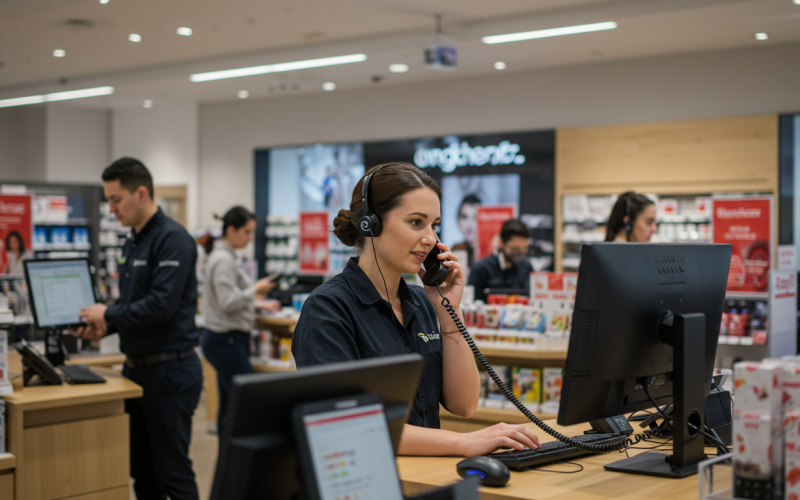UK: 03330 156 651 | IE: 01263 5299
Work From Home Phone System: UK Business Complete Setup
Setting up a reliable work from home phone system has become essential for UK businesses, with 22.8% of employees now working remotely and 98% wanting...
Stephen
Digital Marketing Manager
- Published Date:

Table of Contents
Setting up a reliable work from home phone system has become essential for UK businesses, with 22.8% of employees now working remotely and 98% wanting flexible working options. Whether you’re managing a team of remote workers or establishing your first home office setup, choosing the right business phone system can make the difference between seamless operations and communication chaos.
The challenge isn’t just technical—it’s strategic. How do you maintain professional standards, ensure security, and provide the same level of service your customers expect, all while your team works from kitchen tables and spare bedrooms across the country? This complete setup guide will show you exactly how to implement a work from home phone system that keeps your UK business connected, productive, and professional.

What is a Work From Home Phone System?
A work from home phone system is a business VoIP solution that allows employees to make and receive company calls from any location using their internet connection. Unlike traditional landlines tied to physical offices, these VoIP phone systems operate through cloud technology, giving your team complete flexibility while maintaining professional communication standards.
Think of it as bringing your office phone system wherever your employees go. Whether they’re working from their home office, a coffee shop in Manchester, or a co-working space in Dublin, they can answer calls using your company number, access voicemail, transfer calls, and use all the features they’d have at their desk.
Modern work from home phone systems typically include:
- Cloud-based VoIP technology for internet-based calling
- Mobile and desktop applications for any device
- Professional features like call forwarding, hold music, and auto-attendant
- Integration with business tools like CRM systems
- Advanced security and call encryption
Our iPECS Cloud solutions are specifically designed to support remote working, providing enterprise-grade features through user-friendly applications that work on any device.
Types of Work From Home Phone Systems
VoIP Phone Systems
VoIP (Voice over Internet Protocol) systems are the foundation of most work from home phone systems. Instead of traditional phone lines, VoIP technology converts voice into digital data and transmits it over the internet. This makes them perfect for remote working because they only require a stable broadband connection.
Key VoIP benefits for remote workers:
- Use existing internet connection—no additional phone lines needed
- Make calls from smartphones, tablets, or computers
- Significantly lower costs than traditional business phone systems
- Access to advanced features like voicemail-to-email and call analytics
Best for: Small to medium businesses with good internet connectivity, teams that need flexibility, and companies looking to reduce telecommunications costs.
Cloud Business Phone Systems
Cloud phone systems take VoIP a step further by hosting all the infrastructure in secure data centres. Your business phone system lives entirely in the cloud, which means zero hardware maintenance and automatic updates.
Cloud system advantages:
- No on-site equipment to maintain or upgrade
- Automatic software updates and security patches
- Instant scalability—add users with a few clicks
- 99.9% uptime guarantees with professional SLAs
- Disaster recovery built-in
Best for: Growing businesses, companies with multiple locations, and organisations that want enterprise features without enterprise complexity.
Hosted VoIP Solutions
Hosted VoIP systems combine the flexibility of cloud technology with the robust features of traditional PBX systems. The provider manages all the technical infrastructure while you enjoy professional-grade business phone systems features.
Hosted VoIP features:
- Professional auto-attendant and call routing
- Advanced call analytics and reporting
- Integration with existing business applications
- Multi-site connectivity for distributed teams
- Enterprise-level security and compliance
Best for: Businesses requiring advanced features, companies with compliance requirements, and organisations transitioning from traditional PBX systems.
Microsoft Teams Voice Integration
For businesses already using Microsoft Teams, Microsoft Teams Voice provides seamless integration between your collaboration platform and business phone system.
Teams Voice benefits:
- Native integration with existing Microsoft environment
- Unified communications in one familiar interface
- Video, voice, and messaging in single application
- Enterprise-grade security and compliance
- Simplified training for existing Teams users
Best for: Microsoft-centric businesses, companies heavily using Teams for collaboration, and organisations wanting unified communications.
Setting Up Your Work From Home Phone System
Step 1: Assess Your Current Setup
Before implementing any work from home phone system, audit your current situation:
Internet Infrastructure:
- Test internet speeds at each remote location
- Ensure minimum 1 Mbps upload per concurrent call
- Check for consistent connectivity throughout the day
- Identify backup internet options (mobile hotspots, etc.)
Device Inventory:
- Catalogue existing devices (smartphones, tablets, computers)
- Determine compatibility with VoIP systems
- Plan for any additional hardware needs
- Consider headset requirements for call quality
Current Communication Challenges:
- Map existing phone numbers and extensions
- Identify critical business processes that require phone access
- Document current pain points with remote communication
- Assess security requirements and compliance needs
Step 2: Choose Your VoIP Provider
Selecting the right VoIP provider is crucial for work from home phone system success. Consider these factors:
Service Reliability:
- 99.9% uptime guarantees with SLA protection
- Redundant data centres and backup systems
- 24/7 technical support availability
- Track record of service stability
Feature Requirements:
- Professional auto-attendant and call routing
- Mobile applications for iOS and Android
- Integration capabilities with your existing software
- Call recording and analytics features
UK-Specific Considerations:
- Local UK phone numbers and geographic options
- GDPR compliance and data protection
- UK-based support teams and service centres
- Understanding of UK business communication needs
Yellowcom’s business phone systems are specifically designed for UK and Irish businesses, offering local support, UK data centres, and compliance with all relevant regulations.
Step 3: Plan Your Phone System Architecture
Design your work from home phone system structure:
Number Planning:
- Main business number routing strategy
- Individual extensions for remote workers
- Department-specific numbers (sales, support, etc.)
- Local numbers for different geographic regions
Call Flow Design:
- Auto-attendant menu structure
- Call routing rules for different times of day
- Overflow handling for busy periods
- Integration with existing customer service processes
User Permissions:
- Define who can make international calls
- Set up department-specific calling permissions
- Configure recording policies for compliance
- Establish administrator access levels
Step 4: Configure Security Settings
Work from home phone systems require robust security measures:
Network Security:
- VPN setup for secure connections
- Firewall configuration for VoIP traffic
- Quality of Service (QoS) settings for call priority
- Network monitoring for unusual activity
User Authentication:
- Multi-factor authentication for system access
- Strong password policies for all accounts
- Regular security training for remote workers
- Device management and security policies
Compliance Considerations:
- GDPR compliance for call recording and data storage
- Industry-specific requirements (finance, healthcare, etc.)
- Data encryption for all voice communications
- Audit trails and logging capabilities
Benefits of Work From Home Phone Systems for UK Businesses

Enhanced Productivity and Flexibility
Business VoIP systems eliminate the constraints of traditional office-based communications. Research shows that 61% of remote workers report higher productivity levels, partly due to improved communication tools that allow seamless collaboration regardless of location.
Productivity improvements include:
- No missed calls due to location restrictions
- Instant access to company directory and contacts
- Seamless call transferring between team members
- Integration with productivity tools and calendars
Our iPECS Analytics solutions help track communication patterns and identify opportunities for further productivity improvements.
Significant Cost Reductions
Traditional business phone systems often require substantial upfront investment and ongoing maintenance costs. Work from home phone systems typically reduce communication expenses by 30-50% through:
Direct cost savings:
- Elimination of traditional phone line rental fees
- Reduced hardware purchase and maintenance costs
- Lower international calling rates
- Simplified billing and management
Indirect savings:
- Reduced office space requirements
- Lower utilities and facility costs
- Decreased IT support overhead
- Simplified vendor management
Professional Business Image
A properly configured work from home phone system ensures your business maintains professional standards:
Professional features:
- Consistent caller ID showing company information
- Professional hold music and messaging
- Seamless call transfers between departments
- Voicemail-to-email for prompt response
Customer experience benefits:
- No dropped calls during transfers
- Consistent service quality regardless of agent location
- Professional greeting and routing options
- 24/7 availability through smart call forwarding
Scalability and Business Growth
Cloud business phone systems grow with your business without the limitations of traditional infrastructure:
Scaling advantages:
- Add new users instantly without hardware installation
- Support for seasonal staffing fluctuations
- Geographic expansion without physical infrastructure
- Integration with new business applications as needed
Work From Home Phone System Setup Requirements
Internet Connection Standards
Reliable broadband forms the foundation of any successful work from home phone system:
Minimum requirements per user:
- 1 Mbps upload speed per concurrent call
- Low latency (under 100ms) for clear audio quality
- Stable connection with minimal packet loss
- Backup connectivity options for redundancy
Recommended specifications:
- 5+ Mbps upload for multiple simultaneous calls
- Fiber connections for optimal stability
- Uncontended business broadband for consistent performance
- Dedicated bandwidth allocation for voice traffic
Our business broadband solutions are optimised for VoIP traffic and include QoS features to prioritise voice calls over other internet activity.
Hardware and Software Needs
Essential equipment for remote workers:
Computing devices:
- Modern smartphone (iOS 12+ or Android 8+)
- Computer with reliable internet connection
- Quality headset or USB phone for extended calls
- Webcam for video conferencing integration
Software requirements:
- VoIP software or mobile applications
- Updated web browser for web-based administration
- Security software and VPN client
- Integration applications (CRM, productivity tools)
Optional enhancements:
- Dedicated IP desk phones for home offices
- Professional lighting for video calls
- Noise-cancelling headsets for busy environments
- Wireless headsets for mobility during calls
Network Configuration
Proper network setup ensures optimal VoIP phone system performance:
Quality of Service (QoS) configuration:
- Prioritise voice traffic over other internet usage
- Configure router settings for optimal VoIP performance
- Implement bandwidth management policies
- Monitor network performance regularly
Security configuration:
- Firewall rules for VoIP traffic
- VPN setup for secure remote access
- Network monitoring and intrusion detection
- Regular security updates and patches
Choosing the Right Provider for Your Business
Key Selection Criteria
When evaluating VoIP providers for your work from home phone system, consider:
Service reliability factors:
- Uptime guarantees and SLA commitments
- Geographic redundancy and backup systems
- Customer service availability and response times
- Track record of service stability
Feature comparison:
- Core VoIP features (calling, voicemail, conferencing)
- Advanced features (auto-attendant, call analytics)
- Integration capabilities with existing software
- Mobile applications and remote access tools
Cost considerations:
- Transparent pricing with no hidden fees
- Scalable pricing models for business growth
- International calling rates and packages
- Total cost of ownership including setup and support
UK Market Considerations
Local factors for UK businesses:
Regulatory compliance:
- GDPR compliance for data protection
- Ofcom regulations for telecommunications
- Industry-specific compliance requirements
- Data sovereignty and UK data centres
Local support advantages:
- UK-based technical support teams
- Understanding of local business practices
- Local phone number portability
- Regional presence for on-site support when needed
Geographic coverage:
- Service availability across UK regions
- Coverage in rural and remote areas
- International connectivity for global business
- Disaster recovery and backup services
Yellowcom’s UK-based support teams understand the unique needs of British and Irish businesses, providing local expertise with global capabilities.
Provider Comparison Framework
Evaluate potential providers using this framework:
| Factor | Weight | Evaluation Criteria |
|---|---|---|
| Reliability | 30% | Uptime SLA, redundancy, disaster recovery |
| Features | 25% | Core features, advanced capabilities, integrations |
| Support | 20% | 24/7 availability, local presence, expertise |
| Cost | 15% | Total cost of ownership, transparent pricing |
| Security | 10% | Encryption, compliance, security certifications |
Questions to ask potential providers:
- What’s your average uptime over the past 12 months?
- How quickly can you port our existing phone numbers?
- What integration options do you offer with our current software?
- Where are your data centres located, and how is our data protected?
- What’s included in your support services?
Implementation Best Practices
Phased Rollout Strategy
Implement your work from home phone system gradually to minimise disruption:
Phase 1: Pilot Program (2-4 weeks)
- Select 5-10 early adopters for initial testing
- Test core functionality and identify any issues
- Gather feedback and refine configuration
- Document procedures and best practices
Phase 2: Department-by-Department (4-8 weeks)
- Roll out to one department at a time
- Provide targeted training for each group
- Monitor performance and adjust as needed
- Build internal champions and support network
Phase 3: Full Deployment (2-4 weeks)
- Complete migration of all users
- Decommission old phone systems
- Conduct final testing and optimisation
- Celebrate successful transition and gather lessons learned
Training and Change Management
Successful adoption requires comprehensive training:
Technical training components:
- How to use mobile and desktop applications
- Key features and shortcuts for daily use
- Troubleshooting common issues
- Security best practices and compliance
Change management strategies:
- Clear communication about benefits and timeline
- Regular feedback sessions and Q&A opportunities
- Internal champions to support colleagues
- Ongoing support and refresher training
Training delivery methods:
- Live virtual training sessions
- Video tutorials and documentation
- One-on-one support for key users
- Peer-to-peer learning programs
Ongoing Optimisation
Continuous improvement ensures long-term success:
Performance monitoring:
- Regular call quality assessments
- User satisfaction surveys and feedback
- Technical performance metrics and analytics
- Cost analysis and optimisation opportunities
Feature adoption:
- Identify underutilised features with business value
- Provide additional training on advanced capabilities
- Regular feature updates and new functionality rollouts
- Integration with new business applications
Security maintenance:
- Regular security audits and updates
- User security training and awareness programs
- Monitoring for unusual activity or threats
- Compliance reviews and documentation updates
Troubleshooting Common Issues
Call Quality Problems
Poor audio quality is the most common VoIP phone system issue:
Symptoms and solutions:
- Echo or feedback: Check headset positioning, reduce speaker volume, ensure proper acoustic setup
- Choppy or robotic audio: Test internet speed, check for bandwidth congestion, prioritise VoIP traffic
- One-way audio: Verify firewall settings, check NAT configuration, test with different devices
- Dropped calls: Monitor network stability, check for packet loss, verify provider network status
Prevention strategies:
- Regular network speed testing during peak hours
- Quality headsets and acoustic treatment for home offices
- Backup internet connections for critical users
- Proactive monitoring and alerting systems
Connectivity Issues
Connection problems can disrupt business operations:
Common connectivity issues:
- Cannot connect to system: Verify internet connection, check login credentials, confirm server status
- Intermittent disconnections: Test network stability, check for interference, verify QoS settings
- Slow response times: Check bandwidth utilisation, verify server performance, test during different times
Resolution steps:
- Verify basic internet connectivity and speeds
- Test VoIP service from different devices and locations
- Check provider status pages for known issues
- Contact technical support with specific error messages
- Document issues for pattern identification
Security Concerns
Protecting your work from home phone system:
Common security issues:
- Unauthorised access to phone system
- Eavesdropping on confidential calls
- Toll fraud and unauthorised calling
- Data breaches and compliance violations
Security best practices:
- Strong password policies and multi-factor authentication
- Regular security audits and vulnerability assessments
- Employee training on security awareness
- Monitoring and alerting for suspicious activity
- Encryption for all voice communications
Frequently Asked Questions
How much does a work from home phone system cost?
Costs vary based on features and scale:
- Basic VoIP service: £15-25 per user per month
- Advanced business features: £25-50 per user per month
- Enterprise solutions: £50+ per user per month
- Setup and hardware: £50-500 per user (one-time)
Additional costs may include:
- Professional installation and configuration
- Training and change management support
- Integration with existing business systems
- Ongoing support and maintenance
Contact our team for a customised quote based on your specific requirements.
Can I keep my existing business phone numbers?
Yes, number portability is standard with reputable VoIP providers. The process typically takes 10-15 working days and includes:
Porting process:
- Submit porting request with current provider details
- Verify account ownership and authorisation
- Coordinate transition timing to minimise disruption
- Test new system before final cutover
- Complete transition and verify all numbers work correctly
Requirements for porting:
- Account ownership verification
- Current provider account details
- Letter of authorisation for number transfer
- Coordination of cutover timing
Is a work from home phone system secure?
Modern VoIP systems include enterprise-grade security features:
Security measures:
- End-to-end encryption for all voice communications
- Secure authentication and access controls
- Regular security updates and patches
- Compliance with UK data protection regulations
Best practices for security:
- Use strong passwords and multi-factor authentication
- Keep software and applications updated
- Train employees on security awareness
- Regular security audits and monitoring
Compliance considerations:
- GDPR compliance for data protection
- Industry-specific requirements (finance, healthcare)
- Call recording policies and retention
- Data sovereignty and UK data centres
What internet speed do I need for VoIP calls?
Minimum internet requirements:
- Per concurrent call: 100 kbps (0.1 Mbps) each direction
- Recommended per call: 500 kbps (0.5 Mbps) each direction
- For HD voice quality: 1 Mbps each direction per call
Practical recommendations:
- Small business (1-5 users): 10+ Mbps download, 5+ Mbps upload
- Medium business (5-20 users): 50+ Mbps download, 20+ Mbps upload
- Large operations (20+ users): Consider dedicated business broadband
Additional factors:
- Other internet usage (email, web browsing, file sharing)
- Peak usage times and simultaneous users
- Video conferencing and screen sharing requirements
- Backup connectivity for redundancy
How quickly can I set up a work from home phone system?
Implementation timeline depends on complexity:
Basic setup (1-10 users): 1-2 weeks
- Number porting: 5-10 working days
- System configuration: 1-2 days
- User training: 1-2 days
- Testing and go-live: 1 day
Medium deployment (10-50 users): 2-4 weeks
- Requirements analysis: 3-5 days
- System design and configuration: 5-7 days
- Number porting: 10-15 working days
- Training and rollout: 5-10 days
Large implementation (50+ users): 4-8 weeks
- Detailed planning and design: 1-2 weeks
- Phased rollout approach: 2-4 weeks
- Comprehensive training program: 1-2 weeks
- Testing and optimisation: 1 week
Factors affecting timeline:
- Number of existing phone numbers to port
- Integration requirements with existing systems
- Complexity of call routing and features
- Training requirements and change management
What happens if my internet goes down?
Modern work from home phone systems include multiple backup options:
Automatic failover options:
- Calls forward to mobile phones automatically
- Voicemail continues to function normally
- Call routing to other locations or team members
- Email notifications of missed calls
Backup connectivity solutions:
- Mobile hotspot devices for emergency internet
- 4G/5G backup connections
- Secondary broadband providers
- Temporary call forwarding to traditional phone lines
Business continuity features:
- Multiple data centre redundancy
- Automatic system failover
- Real-time monitoring and alerting
- Disaster recovery procedures
Can I integrate with my existing CRM system?
Most modern VoIP systems offer extensive integration capabilities:
Common CRM integrations:
- Salesforce, HubSpot, Microsoft Dynamics
- Zoho, Pipedrive, SugarCRM
- Custom APIs for bespoke systems
- Zapier integrations for hundreds of applications
Integration benefits:
- Automatic call logging and activity tracking
- Screen pop with customer information
- Click-to-dial from CRM records
- Call analytics tied to customer data
Integration features:
- Real-time data synchronisation
- Customisable field mapping
- Automated workflow triggers
- Comprehensive reporting and analytics
Our business phone systems integrate with over 130 CRM and business applications to streamline your operations.
Taking the Next Step
Implementing a work from home phone system transforms how your UK business operates, providing the flexibility, cost savings, and professional capabilities essential for modern remote working. Whether you’re supporting a handful of remote workers or transitioning your entire organisation to hybrid working, the right business phone system ensures seamless communication regardless of location.
The key to success lies in choosing a solution that matches your specific needs, provides reliable UK-based support, and scales with your business growth. Consider factors like call quality, security features, integration capabilities, and total cost of ownership when making your decision.
Ready to transform your business communications with a professional work from home phone system? Our telecommunications experts understand the unique challenges facing UK businesses and can recommend the perfect solution for your remote working needs.
Get your free consultation today and discover how Yellowcom can help you implement a reliable, secure, and cost-effective work from home phone system that keeps your business connected and productive.
Contact our UK team:
- UK: 03330 156 651
- Ireland: 01263 5299
Join thousands of UK and Irish businesses who trust Yellowcom for reliable business communications that work wherever your team works.

Looking for a Smarter Way to Stay Connected? We Help Businesses Cut Costs and Improve Communication.
Share this post:
SHARE POST
Related Posts
Here’s a statistic that will shock most UK business owners: 68% of small businesses are overpaying for their mobile.
Here’s something that might surprise you: most small and medium UK businesses haven’t reviewed their energy costs in over.
Omnichannel retail communication is about creating seamless experiences where customer data, conversations, and transactions flow effortlessly between every touchpoint..



